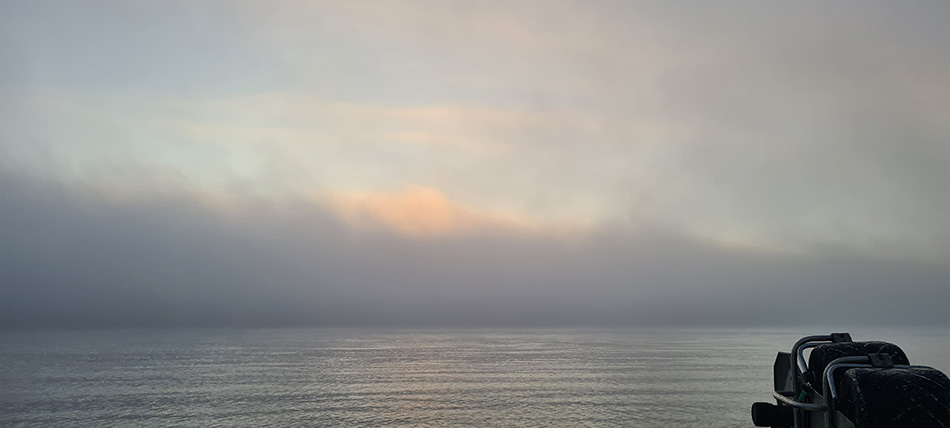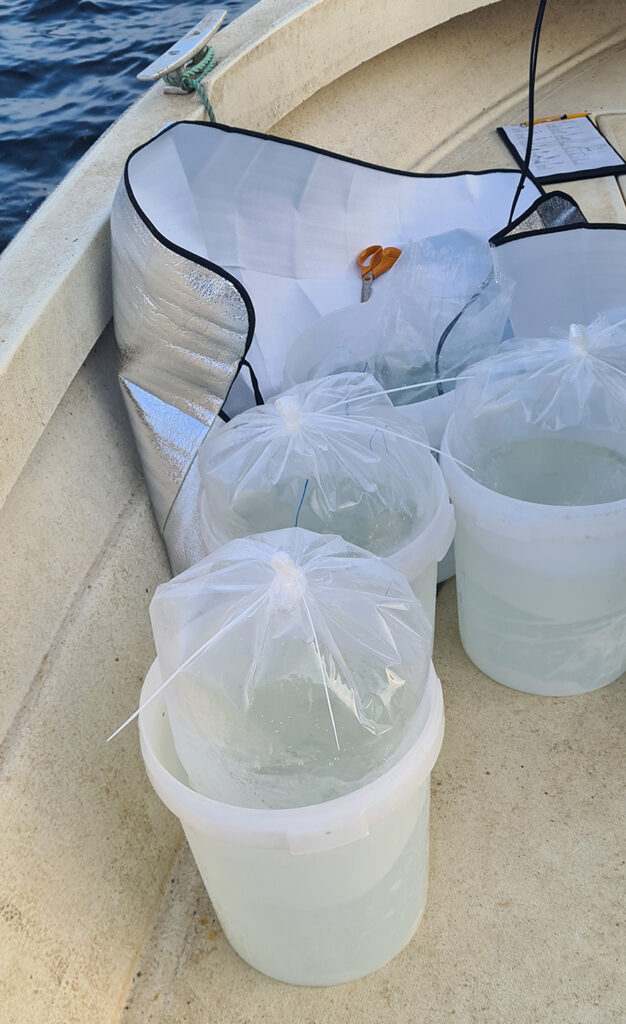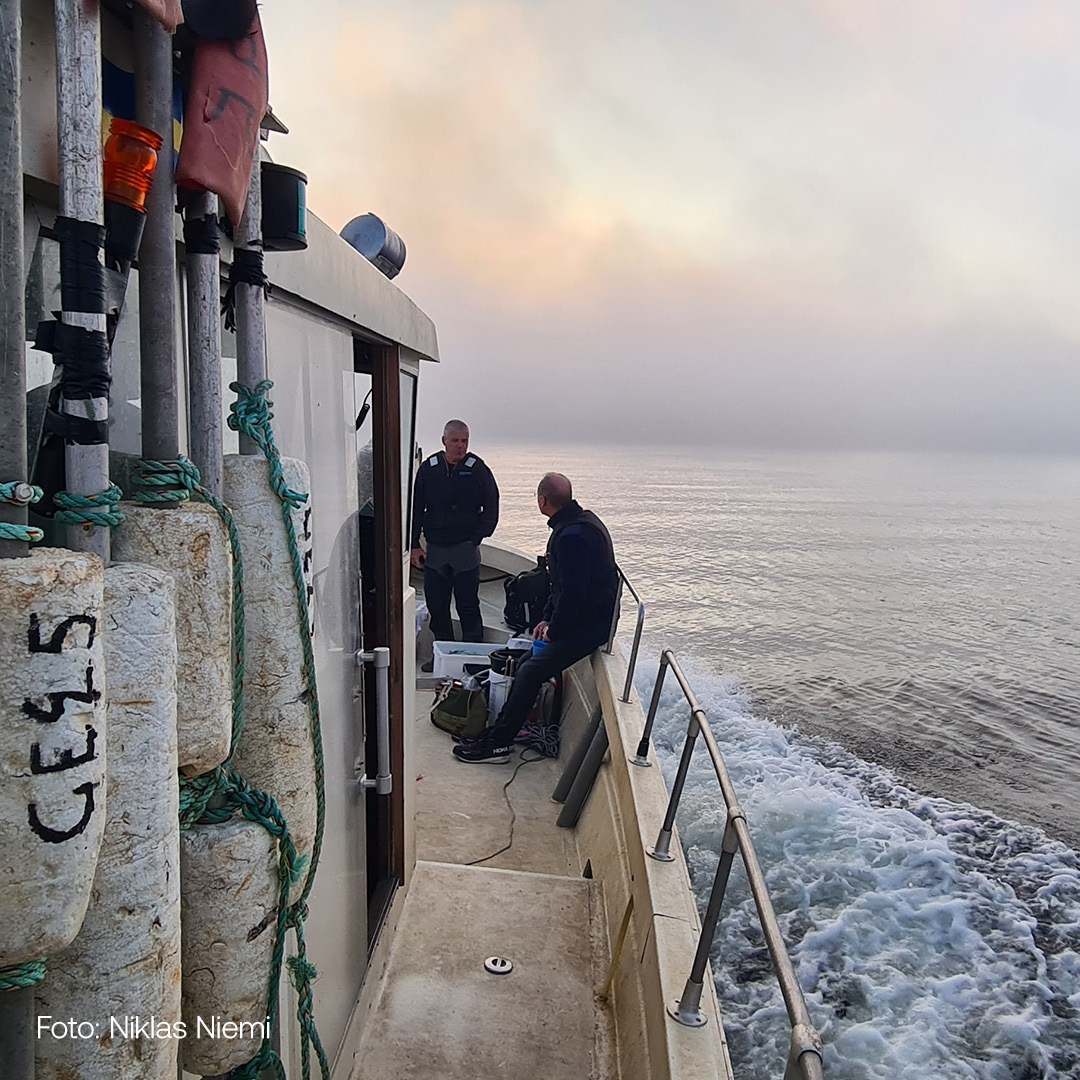It is dawn when BalticWaters and Gävleborg County Administrative Board board the boat in Gävle. On board are 56,000 small cod larvae that travelled overnight from the Ar research station on Gotland to be released into Gävle Bay. The hope is that the release, combined with good management, can help to rebuild the cod stock in the bay.
The fog is thick over Gävle Bay when Johanna Fröjd and Konrad Stralka from BalticWaters set out on the water early one August morning together with Niklas Niemi, fisheries officer at Gävleborg County Administrative Board, and fisherman Tomas Karlsson. As well as contributing to a cinematic mystique, the dense fog blurs all recognisable landmarks. However, with the help of radar and Tomas’s skilful hand at the helm, we can still make our way to Eggegrund at the entrance to Gävle Bay. This is where the cod larvae will be released.

The fog is lifting. Photo: Niklas Niemi
The aim of the release, which was made possible by funding from the Bank of Åland, is to test whether it is possible to re-establish cod in Gävle Bay – an area that previously had plenty of cod but which today lacks the conditions required for cod to reproduce.
– There is a big interest among both the public and local fishermen in the re-establishment of cod here. Many see a need, not least for the ecosystem, says Niklas.
The trial is part of the large-scale ReCod project – release of small cod in the Baltic Sea.
– During the project, we have learnt a lot about the cod eggs and larval stage. However, this is the first time we have released cod larvae so far north in the Baltic Sea, where the salinity is lower, which is a new experience for us, says Konrad.
Since the salinity is low in Gävle Bay, the eggs and larvae of the parent fish have been in a lower salinity than we normally have in the ReCod project. The aim is to adapt the larvae as much as possible to the lower salinity so that they can stay floating in the water mass.
– When the larvae are 4-6 days old, they start to be able to swim, and it is at that age that we believe the larvae have the greatest chance of survival, says Johanna.
The cod larvae, hatched from the Ar research station on Gotland, will be placed in two different locations selected by Gävleborg County Administrative Board after interviews with local fishermen and a careful inventory of environmental conditions. The right levels of oxygen, salt and temperature are required to optimise the larvae’s chances of survival.
Once at the release site, we take another water sample to check the temperature, salt and oxygen levels in the water. With this information in hand, Johanna calculates that the larvae will be released at a depth of 29 metres. The fragile larvae are carefully transferred to the release unit, which is then lowered into the water.

Cod larvae are stored in bags in buckets. Photo: Niklas Niemi

Johanna lowers the release unit with cod larvae into the water. Photo: Niklas Niemi
The cod larvae are placed in the release unit which is lowered into the water. At the right depth, a metal weight is placed on the line. The weight is released and when it reaches the release unit, the valves of the unit open and the larvae are released. Video: Niklas Niemi
It is important to work quickly. Cod larvae are very sensitive to temperature and it becomes more difficult to keep them cool as the sun moves higher and higher above the water. But we are well prepared and after a few turns, all the small larvae are finally released.
As the boat makes its way back to Gävle, a period of patience and waiting begins. The release will be followed up in 2025 to see if the larvae have survived and grown into small fish. But Niklas at the County Administrative Board in Gävleborg is already preparing for future releases.
– The cod larvae should have a good chance of survival, but it remains to be seen, says Niklas.
– Our hope is that continued stocking and good management can help rebuild the cod stock in the Gulf of Gävle, strengthen the entire ecosystem and give our local fishermen renewed confidence in the future, he concludes.
We wish the cod larvae good luck!

About ReCod
Since 2021, the project has been carried out at the Ar research station on Gotland – in the middle of the Baltic Sea. The goal of ReCod is to conduct trials with releases of 4-6 day old cod larvae at a few locations along the east coast where we investigate whether the larvae survive and manage to establish themselves. If the trials are successful, there is the possibility of re-establishing cod in the Baltic Sea in more places, which increases the chances of preserving and protecting the unique eastern stock. ReCod is implemented and funded by BalticWaters and Uppsala University. In addition, a number of partners are contributing to the project in various ways: Leader Gute, Region Gotland, the Swedish University of Agricultural Sciences and the Ulla and Curt Nicolin Foundation. In total, just over SEK 50 million is being invested in the project.
From 2025, the ReCod project will be run at BalticWater’s new fish research laboratory being built outside Nyköping.

